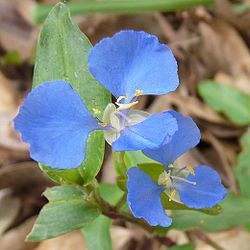- Commelina cyanea
-
Commelina cyanea 
Scientific classification Kingdom: Plantae Division: Magnoliophyta Class: Liliopsida Order: Commelinales Family: Commelinaceae Subfamily: Commelinoideae Tribe: Commelineae Genus: Commelina Species: C. cyanea Binomial name Commelina cyanea
R.Br.Commelina cyanea, commonly known as scurvy weed, is a perennial prostrate herb of the family Commelinaceae native to moist forests and woodlands of eastern Australia,[1] Lord Howe Island and Norfolk Island. The blue flowers appear over the warmer months and are pollinated by bees and flies.
Contents
Taxonomy
Commelina cyanea was one of the many species initially described by the botanist Robert Brown in his 1810 work Prodromus Florae Novae Hollandiae et Insulae Van Diemen and still bears its original name.[2] The genus name Commelina was chosen based on the Asiatic dayflower. Linnaeus picked the name in honour of the Dutch botanists Jan and Caspar Commelijn, using the two large showy petals of Commelina communis to symbolise them.[3] The specific name is the Latin adjective cyaneus, meaning "blue". As well as scurvy weed, alternative common names include (native) wandering Jew, forget-me-not,[2] and creeping Christian.[4]
Description
Commelina cyanea is a trailing herbaceous perennial plant, whose stems grow along the ground.[1] It readily roots at the nodes when they come into contact with the soil. They die off in winter.[5] The leaves are ovate to narrow-ovate, and measure 2–7 cm (0.8-2.8 in) long by 0.5-1.5 cm (0.2-0.6 in) wide. The flowers can occur at any time from spring to autumn.[1] They are deep blue and about 1.5 cm (0.6 in) in diameter, followed by a capsule bearing 2-5 2-3 mm long seeds.[5]
Distribution and habitat
The range across eastern New South Wales, from Narooma northwards, up into Queensland.[1] It also occurs on Lord Howe Island,[6] and Norfolk Island.[7] It grows in wetter shaded areas in forest habitats.[1]
Ecology
Commelina cyanea is pollinated by a variety of native bees such as Nomia aurantifer, Amegilla pulchra, halictid and colletid bees, and syrphid flies (genus Syritta).[8] Wallabies and rabbits eat the vegetation.[5] Vegetation is also possibly dispersed by water.[5]
Uses
The leaves are used as an edible vegetable. The leaves were used by early non-indigenous colonists to alleviate scurvy, and hence its common name. [9]
Attractive in flower, Commelina cyanea adapts readily to cultivation and can be grown as a groundcover or in hanging baskets. It is easily propagated from cuttings.[10] It does resemble the introduced weed wandering jew (Tradescantia fluminensis), but the latter has white flowers and a segmented stem, a weak root system. It also lacks the hairy leaf sheathes of C. cyanea.[11] However, C. cyanea can itself be weedy in gardens at times.[12]
References
- ^ a b c d e PlantNET, plant profile Commelina cyanea. [1]
- ^ a b "Commelina cyanea R. Br.". Australian Plant Name Index (APNI), IBIS database. Centre for Plant Biodiversity Research, Australian Government. http://www.anbg.gov.au/cgi-bin/apni?taxon_id=20463.
- ^ Faden, Robert (2006), "Commelina diffusa", in Flora of North America Editorial Committee, eds. 1993+, Flora of North America online, 22, New York & Oxford: Oxford University Press, http://www.efloras.org/florataxon.aspx?flora_id=1&taxon_id=222000040, retrieved 2007-06-21
- ^ "What's flowering in the park - Commelina cyanea". Friends of Lane Cove National Park website. Friends of Lane Cove National Park. http://www.friendsoflanecovenationalpark.org.au/Flowering/Flowers/Commelina_cyanea.htm. Retrieved 16 April 2011.
- ^ a b c d "Commelina cyanea". Ecology of Cumberland Plain Woodland. Royal Botanic Gardens, Sydney. http://www.rbgsyd.nsw.gov.au/science/Evolutionary_Ecology_Research/Ecology_of_Cumberland_Plain_Woodland/woodland_plants/commelina_cyanea. Retrieved 17 April 2011.
- ^ Rodd, A.N.; Pickard, John (1983). "Census of Vascular Flora of Lord Howe Island". Cunninghamia 1 (2): 267–80. http://www.rbgsyd.nsw.gov.au/__data/assets/pdf_file/0008/97613/Rodd.pdf. Retrieved 16 April 2011.
- ^ Peter Green (23 March 2011). "Norfolk Island National Park - Flora". Department of Sustainability, Environment, Water, Population and Communities website. Commonwealth of Australia. http://www.environment.gov.au/parks/norfolk/nature-science/species-list.html. Retrieved 17 April 2011.
- ^ Geoff Williams, Paul Adam. The Flowering of Australia's Rainforests: A Plant and Pollination Miscellany. Collingwood, Victoria: CSIRO publishing. p. 136. ISBN 0643097619. http://books.google.com.au/books?id=jh6v3D22n6cC&pg=PA136&lpg=PA136&dq=Commelina+cyanea+pollinators&source=bl&ots=ldHnKbtgkI&sig=pTbsnilpHA-PW8fQcjVyFvBTp98&hl=en&ei=2iaqTcvsIIf0vQPz4-yeCg&sa=X&oi=book_result&ct=result&resnum=7&ved=0CEMQ6AEwBg#v=onepage&q=Commelina%20cyanea%20pollinators&f=false.
- ^ Association of Societies for Growing Australian Plants (ASGAP), Commelina cyanea.[2]
- ^ Elliot RW, Jones DL, Blake T (1984). Encyclopaedia of Australian Plants Suitable for Cultivation:Volume 3 - Ce-Er. Port Melbourne: Lothian Press. p. 62. ISBN 0-85091-167-2.
- ^ "Wandering Jew (Trad)". Sydney Weeds Committees website. Sydney Weeds Committees. 2010. http://sydneyweeds.org.au/weed/wandering-jew-trad/. Retrieved 16 April 2011.
- ^ Fairley A, Moore P (2000). Native Plants of the Sydney District: An Identification Guide (2nd ed.). Kenthurst, NSW: Kangaroo Press. p. 325. ISBN 0-7318-1031-7.
Categories:- Commelina taxa by scientific name
- Bushfood
- Commelinales of Australia
- Flora of New South Wales
- Flora of Queensland
- Plants described in 1810
Wikimedia Foundation. 2010.
